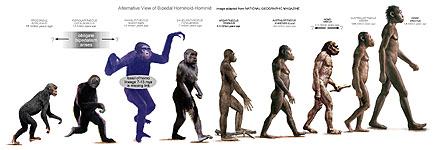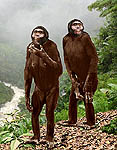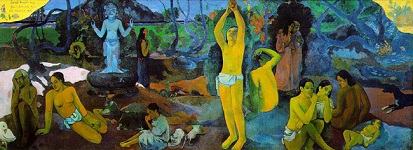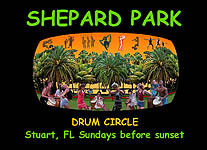MAYA-GAIA INTRODUCTION & SITEMAP Page Update 08 24 07
Note: My Anthropic Trilogy web-book, evolving since 1997, is a chronicle of my passing all considered opinion through the lens of my Nirvikalpa Samadhi with both an open-mind and healthy skepticism.
Examining historic and contemporary approaches to identify and
produce primordial sounds and rhythm to incorporate
into my active meditation practice
"Imagination is the power on which all the errors, superstitions and prejudices of revealed religion rests." - Baruch Spinoza
Update 08 28 2018: This page is a chronicle of the evolution of my improvised bhakti/yoga active meditation that I have been practicing over the past 7 years as a way to commune with my Panendeism G-d. Previously, in my page Kirtan and Bhajan I thought I might find enough interest in our area to form weekly kirtan sessions but I canceled the local kirtan meetup promotion I produced because I couldn't find a presenter. End Update
The most practical option for an introvert like myself is to adopt or improvise a private practice whose anatomy consists solely of spiritual elements that I can truly believe in. My desire is to establish a communion with God to express gratitude and celebrate the gift of life and the grace I feel has been bestowed on me - and since I believe the course of all reality happens according to God's created laws and grace, I do not pray for further blessings on myself, humanity or Gaia's biocosmic nature. My practice is a form of Bhakti, but since I have already been blessed with God realization, the aspiration for moksha - to merge with Brahman or Bodhi - inherent in Hindu and Buddhist yoga - is not in my agenda. However, for aspirants I see no reason why the practice I outline would not have the full potential to serve this ultimate goal as well as Bhakti, Nada or any other traditional yoga or meditative routine.
Jnana Bhakti Tension My personal neo-classical confrontation with the tension between jnana (philosophical concepts) and bhakti (devotional purity) integration of my Nirvikalpa Samadhi and how Primordial Rhythm Mediation provides the resolution for my practice.
Updates on Primordial Rhythm Meditation videos over a Six-Year Evolution
 Primordial Rhythm Meditation Video
The first of my series of Primordial Rhythm Meditation YouTube videos - created back in 2011 - taken offline by me in 2014 but brought back online again in 2018 to chronicle the evolution of my PRM practice.
Primordial Rhythm Meditation Video
The first of my series of Primordial Rhythm Meditation YouTube videos - created back in 2011 - taken offline by me in 2014 but brought back online again in 2018 to chronicle the evolution of my PRM practice.
 Update 09 15 2013:
I've added
Primordial Rhythm Meditation Part 4
video on youtube where Kelsey demonstrates her beginning a practice of PRM.
End Update
Update 09 15 2013:
I've added
Primordial Rhythm Meditation Part 4
video on youtube where Kelsey demonstrates her beginning a practice of PRM.
End Update
Update 02 12 2017: Primordial Rhythm Meditation - Update - An update few years later that shows some variations in my drumming modality in my continuing evolution.
Update 05 24 2017: Primordial Rhythm Meditation Update - Part 2 - An update just a few months after my previous update but featuring a rather dramatic change in how I employ a minimal energy in my drumming that still evokes the voice of the water within the range of the average heart beat tempos. Our mindfulness meditation as we follow the water's voice transforms to a state of mindlessness/no thought/no cognition replicating our state of consciousness as embryos in our mother's womb when our sentient awareness consisted wholly of her heart rhythm.
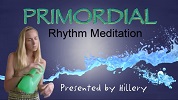 Update 09 15 2017:
Primordial Rhythm Meditation - with Hillery
A presentation by Hillery of her beginning exploration of Primordial Rhythm Meditation.
Update 09 15 2017:
Primordial Rhythm Meditation - with Hillery
A presentation by Hillery of her beginning exploration of Primordial Rhythm Meditation.
Update 09 18 2017: Primordial Rhythm Meditation Update - Part 3 An update to the ongoing evolution of my PRM practice in which I occasionally drift into mindfulness on becoming nataraja and simulate his/her lightly dancing on the body of my drum with my two fingers to a heart beat tempo - following the voice of the water to a state of mindlessness.
 Update 03 08 2018:
Primordial Rhythm Meditation - Update 5
documentary youtube video. An update on over six years of practice that features the optimum drumming tempo and minimal energy for
evoking the voice of the water (that I associate with communion with my ancestors and supreme spirit) and a mindful visualization of
myself as Nataraja - drifting off into states of conscious mindlessness.
Update 03 08 2018:
Primordial Rhythm Meditation - Update 5
documentary youtube video. An update on over six years of practice that features the optimum drumming tempo and minimal energy for
evoking the voice of the water (that I associate with communion with my ancestors and supreme spirit) and a mindful visualization of
myself as Nataraja - drifting off into states of conscious mindlessness.
 Update 04 17 2018:
Primordial Rhythm Meditation- Update 6
- A documentation of a culmination in my PRM practice - where I use a truly minimal energy in drumming to evoke the voice of the water.
Update 04 17 2018:
Primordial Rhythm Meditation- Update 6
- A documentation of a culmination in my PRM practice - where I use a truly minimal energy in drumming to evoke the voice of the water.
 Primordial Rhythm Meditation - Water Drum
Tips for finding a container for an improvised water drum for your PRM practice that can evoke the voice of the water with minimal energy.
Primordial Rhythm Meditation - Water Drum
Tips for finding a container for an improvised water drum for your PRM practice that can evoke the voice of the water with minimal energy.
Nataraja Dance of Creation Youtube Video - Anthropomorphic Nataraja dancing the creation of the universe.
About a year ago, I had a defibrillator implant that seems to be working to induce a much more regular and normal heart rhythm of 70-80 bpm. So combined with the stent that was inserted after a heart attack 15 years ago - I'm grateful to be able to take advantage of remarkable advances in medical technology that may enable me to carry on as a bionic man and complete the HTML5/CSS upgrade of my Anthropic Trilogy web-book - sustained online in an auto-renewable account for the forseeable future - well after I've gone non dual. I did an update to PRM Part 5 after my defib implant to document whatever effects it might induce. End Update
In regards to imagining the state of mind that arises in Primordial Rhythm Meditation - if we contrast jnana and bhakti meditative traditions - the former tends to involve various forms of mental concentration, disciplines or pursuit of intellectual knowledge (as in Vipassana Buddhism) while PRM identifies with the latter that tends to "let go" of the mind (as in the variations of "no mind", "no thought", "freeing the mind". "thoughtlessness", "mindlessness" forms of meditation.
 In PRM, The notion to "follow the voice of the water" evoked by our drumming various tempos over the range of our human heart beat - is
a device to allow our mind to make an involution journey (from mindfulness to mindlessness) back to the embryonic state of "no thought"
- where our non-cognitive brain's only sensory input was from our mother's heart beat, organs and fluids. See:
Meditation States of Mind
End Update
In PRM, The notion to "follow the voice of the water" evoked by our drumming various tempos over the range of our human heart beat - is
a device to allow our mind to make an involution journey (from mindfulness to mindlessness) back to the embryonic state of "no thought"
- where our non-cognitive brain's only sensory input was from our mother's heart beat, organs and fluids. See:
Meditation States of Mind
End Update
Update 05 25 2015: In performing my rhythm meditation over the past couple of years I've also noticed that flicking a variety of fingers on various areas of the drum face is more intuitive and natural ergonomically than pumping my arm to deliver my hand to the drum head as in many traditional modalities of hand drumming. Also - I tend to keep the energy of my drumming to the minimum that still evokes the voice of the water except when I temporarily "give over" the drumming to any ancestor spirits - occasionally generating less predictable inter-sessions of primal, higher-energy orchestration.
My rhythm begins with a slight left-right swaying to a moment of about a 3-second sway to attain a steady monotonous evenly-spaced 3 beats per sway (60 beats per minute). My drumming lasts approximately 30-minutes with spontaneous variation in swaying moments between slow (3 seconds), medium (2 seconds) and fast (1.5 seconds) that match the typical heart rhythm tempos of 60/90/120 bpm. Feeling an end to my meditation - I start to imagine I'm at the edge of a 100,000 year old, firelit campsite at night and begin a time-travel, virtual journey back to the present- gradually reducing the amplitude until the primal sound fades away and I'm returned to the here-and-now - ending the drumming.
How to Give Hands-Only CPR If you see a teen or adult suddenly collapse, call 911 and push hard and fast in the center of the chest to the beat of any tune that is 100 - 120 beats per minute that coincides with the heartbeat of your heart when you're excited such as the classic disco song Stayin' Alive. Note: I timed the song's tempo and it's actually exactly 100 bpm - not 120 - so the meditation drum tempo can range a bit faster. End Update
Heart Rhythm Meditation does not traditionally involve drumming but emphasizes a mindfulness on coherence of breath and heartbeat. Since rhythm is fundamental in PRM, I leave my breath to function automatically and focus on approximating my heartbeat pulse for my primary rhythm and its acoustic signature to determine the range of tempos of my drum beat. It happens that these tempos fall closer to the lower frequency of Delta brain waves so that the basic character of my swaying and drumming is virtually unchanged from my original orientation to the entrainment concepts and relied more on my felt "intuition". However the synergy of heart rhythm and brainwave biofeedback strengthens confidence in both my conceptual and intuitive sense. Since we all share similar heart rhythms - the PRM practice assumes a greater collective conformity than if we depended more on the vagaries of our individual "intuition".
As the ontogeny of the embryo evolves.....and its sense organs mature, the fetus begins to sense/hear through the amnionic fluid the double acoustic pulse that is the signature of the mother's heartbeat.
Music Cognition and Embodiment: Chapter 4. by Vijay Iyer. Motion is often induced in infants or toddlers via music, but this behavior is not universal, involuntary, or even reliable. This capacity to entrain to a regular aural pulse may be an evolutionary vestige of a previously useful ability that has more recently fallen into disuse. While nobody can account directly for this phenomenon, it clearly involves regular, rhythmic bodily movement as a kind of sympathetic reaction to regular rhythmic sound -- that is, as a kind of dance. Tactus: The tactus has been long understood to mean the moderate-tempo pulse present in most rhythmic music. Typically when asked to tap a finger or foot to a piece of music, listeners choose a regular time period that is in the approximate range of 300 to 800 milliseconds, averaging a little slower than 2 beats per second (Fraisse 1982). As the music gets faster, a listener is inclined to find progressively slower pulses such that they fit within this range, and vice-versa. The tactus range is also the range of "spontaneous" tempo, that is, of the tempo produced by the typical person asked to tap a steady pulse. This range coincides with a moderate walking pace, a human heartbeat, the rate of jaw movement in chewing, and the infant sucking reflex. It is also a fairly comfortable rate at which to tap a foot or a finger, since it is neither too fast for motor control, nor too slow for accurate, regular timing. Hence the tactus seems to correspond to natural timescales involved with human motion; we might imagine a chipmunk to have a faster tactus.
cardiac cycle The entire cardiac cycle is divided into three principle stages, namely, Atrial systole, Ventricular systole and Diastole. Among the three stages, the first two involve the major or important expansion and contraction of the heart while the third one involves the preparatory stage of the next heartbeat. For each heartbeat or pulse, the atria contract and push blood into the ventricles. A split second after the atria contract, the ventricles begin to contract. As the pressure in the ventricles increases, the AV valves close, to prevent blood from flowing backwards. The sound made by the AV valves closing is the first thump (acoustic signal) of the heart beat. The ventricles contract and push blood out through the arteries. The ventricles then relax, and the aortic and pulmonic valves shut down, to keep the blood from flowing back into the heart. The sound of these valves closing causes the second thump (acoustic signal). The atria then fill up again with blood flowing to them from veins, to begin the next cardiac cycle.
Figure 1 Waveform of a normal heart beat. S1 denotes first acoustic signal - S2 denotes second acoustic signal. Heart beat showing two-throbs per beat.
mp3 audio file A clip of a electroacoustic soundtrack of a beating heart - the rhythm and double throb that is our primordial sensory experience all during our fetal development throughout the past few millions of years of our hominid evolution. Audio clip of three heartbeats with double throb.
The Relationship Between Heart Rate & Music Cardiovascular, cerebrovascular, and respiratory changes induced by different types of music in musicians and non-muscicians: the importance of silence.
Human/chimp common ancestry was between 5 to 8 mya. Chimpanzee Heart Rate Journal of the American Heart Association - Origin of body surface QRS and T wave potentials from epicardial potential distributions in the intact chimpanzee, 1977 - We then obtained the largest male chimpanzee that we could, one that weighed 80 pounds and was estimated to be nine years old. We elected to study this chimpanzee as a counterpart of the adult human and selected a three-year-old male chimp that weighed 35 pounds to study as a counterpart of a school-age child. The spontaneous rates were 92 and 105 beats per minute for the large and small chimp.
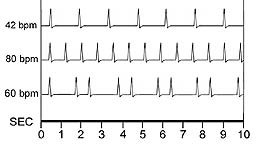 Possibly due to my 15 years of athletic scuba diving I've a slower than average heart rate and now at age 85 my heart pulse ranges
from less than 40 bpm at rest up to around 80 bpm excited. We are imprinted with the rhythm of both our mother's heartbeat and likely
whatever variations our own organ produces over a lifetime- and can use this to establish our meditation's swaying rhythm. After a year
of practice I "feel" comfortable in each session, alternating between a drum tempo based on either the double acoustic heart signal or
the heart rate pulse.
Possibly due to my 15 years of athletic scuba diving I've a slower than average heart rate and now at age 85 my heart pulse ranges
from less than 40 bpm at rest up to around 80 bpm excited. We are imprinted with the rhythm of both our mother's heartbeat and likely
whatever variations our own organ produces over a lifetime- and can use this to establish our meditation's swaying rhythm. After a year
of practice I "feel" comfortable in each session, alternating between a drum tempo based on either the double acoustic heart signal or
the heart rate pulse.
I recently took my pulse over a number of days at different times and found a range of typical bpm and rhythms as well as fairly common skips. The chart illustrates my most common tempos but there are periods where my rhythm is even slower and/or more erratic.
Rhythm Regulates the Brain 2014 Dr. Bruce Perry, MD and other trauma experts are reporting revolutionary success with treatments using yoga, meditation, deep breathing, singing, dancing, drumming and more. The rhythm of these experiences matter. The brain stem and diencephalon contain powerful associations to rhythmic somatosensory activity created in utero and reinforced in early in life. One of the most powerful sets of associations created in utero is the association between patterned repetitive rhythmic activity from maternal heart rate, feeling "safe" (in the womb). Rhythm is regulating. All cultures have some form of patterned, repetitive rhythmic activity as part of their healing and mourning rituals - dancing, drumming, and swaying.
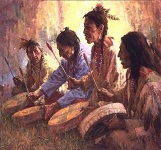 The heartbeat is central to sacred drumming of many tribal cultures all over the world and even when a group of celebrants sit
surrounding the large Host Drum at Native American pow-wows - the most common tempos are monotonous, non-syncopated rhythm within the
range of the human heart rate. Within some societies, the beat of the drum represented the heartbeat of the earth and of the people
and playing the drum brought the world back into balance. In the
Native American pow wow
the featured Host Drum is made from a wooden shell covered in rawhide. It has an average size of about twenty six inches in diameter
and can seat about eight singer/drummers around it. Over millennia primitive tribes adopted many genre and nuances that overlay the
basic repetitive (monotonous) character of the primordial rhythm - a tradition that continues in the largely social ambience of
ccontemporary pow wows where creative and trickey elements are often inserted into the orchestral mix of the drumming.
The heartbeat is central to sacred drumming of many tribal cultures all over the world and even when a group of celebrants sit
surrounding the large Host Drum at Native American pow-wows - the most common tempos are monotonous, non-syncopated rhythm within the
range of the human heart rate. Within some societies, the beat of the drum represented the heartbeat of the earth and of the people
and playing the drum brought the world back into balance. In the
Native American pow wow
the featured Host Drum is made from a wooden shell covered in rawhide. It has an average size of about twenty six inches in diameter
and can seat about eight singer/drummers around it. Over millennia primitive tribes adopted many genre and nuances that overlay the
basic repetitive (monotonous) character of the primordial rhythm - a tradition that continues in the largely social ambience of
ccontemporary pow wows where creative and trickey elements are often inserted into the orchestral mix of the drumming.
youtube Ponca Powwow 2012 "Chorus Girls Song"
Heartbeat: Voices of First Nations Women
See:
track listing - 133 Northern Lights (Crying Women Singers)
Rhythm: 3 beats-per-sway (as relates to the orchestration of my heart beat drumming meditation) and
track listing - 132 Mother (Ulali)
Rhythm: 4 beats-per-sway (as relates to my trying quadruple-drumbeats per sway as in the
bum-dum-dum-dum
rhythm of the vintage Hollywood cowboys and indians soundtrack but found it confused integrating with heart rhythm.
Oklahoma Intertribal Powwow
- example of many pow wow videos on YouTube.
End Update
 The Shape of Green:
Aesthetics, Ecology and Design
by Lance Hosey, 2012 The shape toward which a complex system evolves is a strange attractor. The movers and shakers of ecology, strange
attractors shape much of nature--the dance of planets, the motion of oceans. The
Acacia tortilis,
dominates the African savannah, where its silhouette emblazoned on the human retina for thousands of millennia, and research verifies
that people are drawn to its shape--broad, spreading canopies and branches close to the ground. Evidence suggests that the operative
feature of acacia-like imagery is not its overt expression of the savanna but, instead, the underlying order of its self-similar, not
self-identical, fractal that look looser, softer, less rigid and mechanical. (m-g comment:
The significance of the 'acacia effect' is that it may provide the visual equivalence to the 'heart beat' effect to our sense of hearing as
it relates to embodied cognition and the serenity it provides when we integrate our epigenetic memory in a 'strange attractor' designed space
or in practicing our meditation.)
The Shape of Green:
Aesthetics, Ecology and Design
by Lance Hosey, 2012 The shape toward which a complex system evolves is a strange attractor. The movers and shakers of ecology, strange
attractors shape much of nature--the dance of planets, the motion of oceans. The
Acacia tortilis,
dominates the African savannah, where its silhouette emblazoned on the human retina for thousands of millennia, and research verifies
that people are drawn to its shape--broad, spreading canopies and branches close to the ground. Evidence suggests that the operative
feature of acacia-like imagery is not its overt expression of the savanna but, instead, the underlying order of its self-similar, not
self-identical, fractal that look looser, softer, less rigid and mechanical. (m-g comment:
The significance of the 'acacia effect' is that it may provide the visual equivalence to the 'heart beat' effect to our sense of hearing as
it relates to embodied cognition and the serenity it provides when we integrate our epigenetic memory in a 'strange attractor' designed space
or in practicing our meditation.)
Consciousness: Chaotic and Strangely Attractive by Allan Combs. Rather than discrete things and independent events, there are but ripples upon ripples upon waves upon waves in this universe, propagating in a seamless sea. Ervin Laszlo
In the mid 1970s psychologist Charles Tart described several types of processes that stabilize a state of consciousness. One of the most important of these is loading stabilization, or in plain English keeping a person busy with activities that support the desired state. For certain ecstatic states this might include chanting, or the repetition of a prayer or mantrum, but in the case of ordinary reality it usually means staying productively busy. Tart's ideas are of the first order, but can benefit from more recent advances in the sciences of complexity, which yield more dynamic and fluid conceptions of the nature of systems. For example, a state of consciousness can be reconceptualized as an attractor. Speaking informally, an attractor is a condition to which a system is drawn by its own nature.
The human heart, for instance, runs through its cycle many times each minute. The moon passes through its various phases each month. These, and many others, are instances of systems that naturally settle into predictable cyclic routines. Most interesting, however, are the class of attractors that are neither fixed nor precisely predictable. These are termed strange or chaotic attractors.
On close inspection the cyclic rhythm of the human heart is found not to be precise, like the motions of a clock, but only approximately so. It's global form is well known and easily recognized, but the precise action of an individual heart differs from beat to beat, thus defying exact prediction. Moreover, it is unlikely that the heart ever, in the strictest possible sense, repeats itself the same way twice. This situation of global familiarity but non- predictability, along with the idea that the system never exactly repeats itself, is exactly what defines a chaotic system, one whose action is described by a strange attractor. Though it is often difficult to completely satisfy these criteria in particular instances (Rapp, 1993), systems of this general type are found abundantly in nature, including biological systems such as the human brain (e.g., Basar, 1990; Pribram, 1994).
Is Our Heart Vital for Integration not Only of Body and Mind -
But of Emotions and Spirituality as Well?
A Man After His Own Heart by Charles Siebert, 2004. A story about modern science's latest startling discoveries concerning both the heart's biological origins and its long-intuited role in the emotional quality of our life experiences. Consider the fate of Schroeder,the second - and longest-surviving - receipient in 1984, of the Jarvik-7 artificial heart. As a pump the Jarvik was a resouding success, keeping Schoeder alive for an unpresidented 620 days. The patient's mental/emotional state was another matter beoming weepy and deeply despondent. (Barney Clark, the first Jarvik-7 receipient, expressed a wish to die or be killed.) The blood still circulated, but something vital - some emotionally charged communication between heart and mind - had beome lost.
The science of the heart and Sri Ramana Maharshi by Theo Talcott, 2009. The modern science about the heart and the teachings of Indian sage Sri Ramana Maharshi have much in common. The similarity suggests Ramana experienced truths that science has caught up with 50 years later. Ramana used personal experience and the yogic sciences to map these inner realities. Modern scientific methods maps the heart's biological and neurological structures. And surprise surprise, they are talking about the same things.
No Ideas But In Things to awaken a way back to embodied knowing Parabola Magazine - Spring 2013, by Rabi Joshua Boettiger . The author compares the extent various religious and spiritual traditions - exile or better integrate the body in their philosophies and practices. The World Is Spirit. It is easy to think of ourselves as "spirits in the material world", or the B-side of this, material beings in a spiritual world, but both are models of alienation. Judaism doesn't make the distinction that is our legacy in the West about the essential separateness of mind and body. We are nefahot - simultaneously spirit and body, with each inextricably intertwined in the other during this lifetime. It is written in the Talmud, "Just as the Holy One of Blessing fills the world, so does the soul fill the body." This teaching not only gives us a sense that this world in home, but it also gives us a mandate to work with the body as the primary vessel for encountering God. In recent years, there has been a welcoming back of the body in the West. Different traditions, including Judaism, are trying to bring the body back from its long exile, and to explore how somatic practice might again inform and infuse our traditions. But it is not just that the body is an important "component" of spiritual work, or that we can accomplish embodiment through shoe-horning movement exercise into our prayer. The body is the heart of it all, is the very ground of the work itself. Tibetan Buddhist teacher Reggie Ray has given the critique that many of our spirtual practices today are taught as neck-up endeavors; for instance, we teach a relationship to breathing practice in meditation that makes the breath into a concept as opposed to something that we experience in the body, Ray writes, "We are attempting to practice meditation and to follow a spiritual path in a disembodied state, and this is inevitably doomed to failure. Even when we are supposedly attending to our bodies, we are usually still in our heads. We are not in contact with our actual bodies. We have thoughts about our body but very little direct experience of the body itself."
Background In the Evolution of My Primordial Rhythm Meditation
My extreme skepticism in regards to virtually all spiritual and religious protocol other than that supported by my direct experience and described in my Maya-Gaia pages has led me to explore the most primordial traditions humans have used to imagine connection with invisible "spirit". The features in my current meditation have been drawn from a broad body of works relating to Vedic, Buddhist and Daoist non-dual traditions, Sufism, primordial sound, drum meditation and shamanism and viewing and listening to youtube presentations to find elements I can incorporate into a practice (a work in progress) I find credible. In preliminary trials, I've composed my meditation with the following features/concepts:
Since my voice has become quite feeble in my old age I've chosen drumming for the sound and rhythm as mantra to accompany my meditation.
I can accept that Om (Aum) is the primordial sound of creation but it may be the archetype for the cosmic microwave background radiation left over from the Big Bang. Since I have spent the past 50 or so years listening to FM inter-station white noise to block out random sounds while sleeping and part of this sound is converted background radiation- I feel I acknowledge its presence every night so do not incorporate it's mantra into my primordial sound meditation.
 Shamanism
- originally referred to the spiritual practice specific to Siberian tribes that has been passed down from neolithic times. The shaman
attains an auto-hypnogenic state via ritual, dancing, drumming and entheogens to delve into the spirit world for revelations concerning
the fate of an individual or the collective. Later anthropological research found so much core similarity within a wide range of diversity
of ritual, symbolism and mythology in primitive cultures throughout the world that the term shaman is generic for the practitioner of a
great variety of aboriginal spiritual traditions. The shamanic seance is both a religious ceremony and an artistic performance. The
fundamental purpose of the dramatic displays seen during shamanic ceremonies is not to draw attention or to create a spectacle for the
audience as many Westerners have interpreted, but to lead the tribe in a solemn religious function. In general, all performances consist
of four elements: dance, music, poetry and dramatic or mimetic action. The drum, representing the universe in epitome, is often divided
into equal halves to represent the earth and lower regions. Symbols and natural objects are added to the costume and drum representing
natural forces and heavenly bodies.
Shamanism
- originally referred to the spiritual practice specific to Siberian tribes that has been passed down from neolithic times. The shaman
attains an auto-hypnogenic state via ritual, dancing, drumming and entheogens to delve into the spirit world for revelations concerning
the fate of an individual or the collective. Later anthropological research found so much core similarity within a wide range of diversity
of ritual, symbolism and mythology in primitive cultures throughout the world that the term shaman is generic for the practitioner of a
great variety of aboriginal spiritual traditions. The shamanic seance is both a religious ceremony and an artistic performance. The
fundamental purpose of the dramatic displays seen during shamanic ceremonies is not to draw attention or to create a spectacle for the
audience as many Westerners have interpreted, but to lead the tribe in a solemn religious function. In general, all performances consist
of four elements: dance, music, poetry and dramatic or mimetic action. The drum, representing the universe in epitome, is often divided
into equal halves to represent the earth and lower regions. Symbols and natural objects are added to the costume and drum representing
natural forces and heavenly bodies.
I reduce the tone, tempo and symbolism of generic shamanic drumming to what I feel is the bare essential archetype of primordial sound. The featureless character of this drumming is an asset because- 1. it requires no talent or skill beyond the sense of rhythm that every human posses and 2. it restrains the urge to go beyond slight variation in tone and tempo and be creative and improvise to higher levels of musical virtuosity that would distract from the meditative journey. (My Goombay Experience has convinced me that complex drumming (African, Indic, Sufi, Fusion, etc) can excite temporary episodes of totally inexplicable collective possession by psychic or spirit mechanisms that are usually benign but that are explicitly distinct from the continuum that leads to communion and with grace can culminate in samadhi and transcendence with godhead.
Since I reject most all the traditional symbolism surrounding the drum- mine can have any material and form. I tested the quality of sound of finger-tapping various plastic containers (caps removed) from the typical one gallon water jug to slightly heavier-bodied detergent bottles. At this time I was creating a webpage Enigmatic Synchronicity exploring episodes of synchronicity surrounding the color cyan green, I was drawn to the last bottle of laundry detergent I had purchased before the incident that triggered my interest in that color which by pure chance was made of plastic exactly that hue. When I transferred its contents and rinsed it out- it turned out also to have the most satisfying tone of all my previous samples. It produced a fair, low-amplitude simulation of a shaman hoop or frame drum when held upright by its handle with my one hand and tapped lightly with the fingers of my free hand. This is the drum I initiated to be my sacred drum. In further trials, I found it resonated best when I held the drum loosely and when held near my head required minimal force to resonate into my consciousness with a consistent tone. I find natural variations in tone and rhythm arise in my unskilled drumming and dance that tempt me to adopt more complex patterns of orchestration and choreography. I intend to resist this impulse and stick to the bare essential (monotonous) character of my practice.
Native American people are practical about carrying on tradition and don't hesitate to use modern tools and materials. At pow wows, singers use handmade elk or deerskin drums but also use transistor amplifiers and I-pod recorders to transmit the primordial sounds. They litter their reservations and celebration sites with trash because the surface of the ground is considered just the outer skin of the body of Earth's sacred spirit reality.
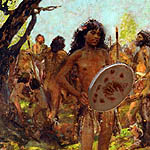 It also reveals how natural it was for our creative species to be tempted to invent increasingly complex symbolism surrounding every
aspect of spiritual ritual in an effort to enhance its sacredness and "power" to get God's attention. As far back as 78,000 years ago,
there is evidence our ancestors used red ocher probably to decorate themselves in ritual dance to the rhythm of drums. Ever since
Paleolithic hunter gathers created monumental stone temples some 12,000 years ago in southern Turkey at a site named
Gobekli Tepe
that gave birth to organized religion, triggering the calamity of civilization- a dynamic body of religious myth and ceremony has grown
with infinite diversity and elaboration in a constant state of evolution and involution. Tragically- one such
tradition
has recently grown (metastasized) a virulent denomination embracing a militant political agenda that literally threatens suffering,
extermination and global catastrophe for all humanity that does not submit to the hegemony of its intolerant fundamentalist ideology
and has created theocratic states that instigate the abomination of a decree of death for anyone who attempts to convert to any other
faith.
It also reveals how natural it was for our creative species to be tempted to invent increasingly complex symbolism surrounding every
aspect of spiritual ritual in an effort to enhance its sacredness and "power" to get God's attention. As far back as 78,000 years ago,
there is evidence our ancestors used red ocher probably to decorate themselves in ritual dance to the rhythm of drums. Ever since
Paleolithic hunter gathers created monumental stone temples some 12,000 years ago in southern Turkey at a site named
Gobekli Tepe
that gave birth to organized religion, triggering the calamity of civilization- a dynamic body of religious myth and ceremony has grown
with infinite diversity and elaboration in a constant state of evolution and involution. Tragically- one such
tradition
has recently grown (metastasized) a virulent denomination embracing a militant political agenda that literally threatens suffering,
extermination and global catastrophe for all humanity that does not submit to the hegemony of its intolerant fundamentalist ideology
and has created theocratic states that instigate the abomination of a decree of death for anyone who attempts to convert to any other
faith.
I do not like the loud amplitude or sharp tone of much shamanic drumming particularly where a hard drum stick or strap is used to displace the hand or a well-padded drumstick. The finger taping produces an acoustic amplitude sufficient to immerse my hearing in the rhythm of the beat without disturbing my condominium neighbors. Hand drumming allows a rich complex of nodes for each drum beat as a result of the number of fingers involved and how and where they impact the drum surface. This is an active meditation that can immediately be established as a practice by anyone and particularly suitable for seniors and others who may find various forms of yoga physically and/or mentally challenging. For anyone with other physical limitations, the rhythm meditation can be performed perfectly well while seated.
I previously performed an improvised drum initiation that consisted of dedicating it to Sat-Chit-Ananda in accordance with the visualization described below (with the addition of specifically acknowledging the diatom creatures whose oil-rich plasma laid down a billion years ago, produced the petroleum from which the body of my drum arose). My drum rests in a place of honor in my home and I do not play it casually as it is now sacred.
In addition to the color cyan-green I have decided to include another symbolism to my ritual and start by adding a vial of ordinary drinking water (about 1 fl. oz.) to my drum container with the thought that it is the elixir of all life as we know it. The imagined scenario is that it might assimilate whatever positive "spirit" that may result from my drumming session. (At the close of my meditation I drink it and sprinkle whatever drops remain over myself - which drains water that could cause mold and fungus build-up between meditation sessions and also created a stand so that it rests inverted to further insure no moisture accumulates.)
Update 12 17 2012: Due to a recent disturbing incident in the middle of a meditation where I was in a semi-trance and my drum slipped from my grasp and fell to the floor - I now insert my hand through a looped cord I attached to the handle of my drum. End Update
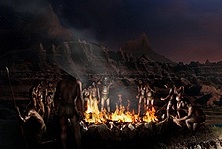 Update 08 27 2012:
No acoustical instrument has greater antiquity and variety in what it is made of, the manner by which it is played and the complex of its
orchestration- than the drum. Even my little plastic sacred drum, played by hand within the limits of tempo of our heart rhythm, presents
subtle sound effects that vary depending on how it is held by one hand and how the fingers and palm of the playing hand impact various
areas of its surface. Combined with coordinating the swaying rhythm and the extrapolation of meditative consciousness, the permutations
and combinations of all factors provide an acoustic/conscious composition that is a challenge that a year later, I am still trying to
cohere. Enter an effect recently that I had not anticipated- the voice of the water. The first time I heard this sound I thought it was
a whisper from some mystery spirit that sent chills down my spine. It took several more weeks of meditative sessions before I confirmed
that the subtle sounds were merely the water sloshing around and that a deliberate, delicate combination of drumming/swaying can produce
a faint ululating watery harmonic to my drum beat. I now deliberately sustain its presence in all modalities of my drumming as it seems
to provide an audible monitoring that indicates when the drumming orchestration is integrated at full potential for bhakti communion.
Update 08 27 2012:
No acoustical instrument has greater antiquity and variety in what it is made of, the manner by which it is played and the complex of its
orchestration- than the drum. Even my little plastic sacred drum, played by hand within the limits of tempo of our heart rhythm, presents
subtle sound effects that vary depending on how it is held by one hand and how the fingers and palm of the playing hand impact various
areas of its surface. Combined with coordinating the swaying rhythm and the extrapolation of meditative consciousness, the permutations
and combinations of all factors provide an acoustic/conscious composition that is a challenge that a year later, I am still trying to
cohere. Enter an effect recently that I had not anticipated- the voice of the water. The first time I heard this sound I thought it was
a whisper from some mystery spirit that sent chills down my spine. It took several more weeks of meditative sessions before I confirmed
that the subtle sounds were merely the water sloshing around and that a deliberate, delicate combination of drumming/swaying can produce
a faint ululating watery harmonic to my drum beat. I now deliberately sustain its presence in all modalities of my drumming as it seems
to provide an audible monitoring that indicates when the drumming orchestration is integrated at full potential for bhakti communion.
Update 10 10 2014:
I just Googled "udu water drum" to see about references to water drumming and learned the following:
Udu
Wikipedia: The udu is both an African plosive aerophone (in this case implosive) and an idiophone--not a drum--used by such peoples
as the Igbo of Nigeria. Actually being a water jug with an additional hole, it was played by women for ceremonial uses. Usually the
udu is made of clay. The instrument is played by hand and produces a special and unique bass sound by quickly hitting the big hole.
Today it is widely used by percussionists in different music styles.
The Igbo thought the ethereal sounds of the udu to be voices of ancestors past.
Water Drum
Water drums are common in Native American music, and are the traditional drum for the Huron/Wendat/Wyandot and Iroquois/Haudenosaune
tribes. The Ojibwa, Ottawa and Pottawatomii called them midegwakikoon. It is used today both ceremonially and in traditional Longhouse
social dances.
Native American Water Drum
The Iroquois water drum is a small cup-shaped wooden vessel, with water inside it, and a moistened tanned hide stretched across the top
opening; the wetness and tightness of the tanned hide produce changes in pitch as the water drum is played over time. The
Yaqui water drum
is actually a half gourd, large in size, that floats in a tub of water like a bubble on the surface; the outer round surface of the
gourd is struck with a drum stick, and the vibrations are amplified using the tub of water as a resonator. See
Hadourium
Water drum improvisation by
Akira Sunrise
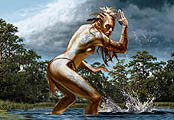
Water Drumming-
documentary videos of indigenous in situ water drumming from The Rainforest world Music festival, Kuching, Sarawak, Malaysia 2011. See related videos of Baka (Central Africa) and other traditions.
Vladiswar Nadishana
a Russian virtuoso plays an evolved engineered form of udu
The Fiberglass Liquid Meinl Ibo
that includes a third hole covered with a drumhead and adds water for the complex compositions he performs. See youtube performance
Solo on Water Udu.
End Update
References to New-Science and Metaphysics of Water
Update 06 21 2017:
Water Science
An exploration into the mythos and physics of the element that makes up 80 percent of our body and that all
life on earth
shares in continuum with the biogenic universe.
Is Masaru Emoto For Real?!!
Open minded critical analysis of t, Castleton State College, Vermont - This essay and extensive subsequent commentaries provide a
review of the published work by Masaru Emoto describing his theories concerning experiments he conducted on the quality and constitution
of various water samples featuring interpreting the configuration of their ice crystals as an indicator of their relative natural purity.
(The purest spring water having perfectly symmetrical crystals while those of polluted water become disorganized to the degree of their
contamination.) He also has claimed subjecting water to things like music and prayer can result in enhanced symmetry of their ice
crystals. (I have no opinion as to the credibility of most of these claims but am particularly skeptical of prayer as my meditation
philosophy does not include prayer of any kind but features gratitude and reverence to Supreme Consciousness for the gift of life.)
Science of the Organism: Water Index of articles from the Science in Society Archive on biological water by Dr. Mae-Wan Ho featuring paradigm of quantum field physics and epigenetics.
Science of Epigenetics and Water
Interview of Dr. Mae Wan Ho: Q6: To the Hindu-Yogi, meditation has long been professed to have healing abilities. Has the new science
of epigenetics begun to support this belief? Can our minds change gene expression with the practice of meditation?
A: There is no doubt that mind-body exercises of all kinds are capable of changing gene expression. It breaches the mind body divide
that's the hallmark of mechanistic western science. Like people from other great cultural traditions in the world, I have never
subscribed to the mind-body divide. I would wager that mind-body exercises could mark and change genes as well; and evidence for that
would emerge before long.
Nigel Stanford - Cymatics youtube video demonstrating intergrated interface - music/matter/water End Update
Next I salute my drum forward, below and above to acknowledge and dedicate my meditation to the component realms of Sat and Chit within Ananda adapted from Vedic concepts:
Sat
- is the static unmanifest universal energy (and spirits of deceased members of my family and ancestors - their selves dissolved in the
Brahmic ocean of non dual light, bliss, love.). I want to stay on good terms with all I never knew, to avoid any
Ancestry Dreams
issues). I extend my love to the spirits of my mother, father, sisters and brother and respect to the collective of all my human ancestors.
Chit
- is dynamic manifest
reality
(universal biocosmic nature). (I do a rapid visualization of zooming out from my mind, my Self, my symbiotic body, nature, light, water,
air, all the elements and Earth, the solar system, the galaxy, the universe,)
...then in a seamless transition - I visualize a flash of light - as I raise my drum to...
Ananda - is the Eternal All - light/bliss/love of non dual integration and union with Brahman consciousness.
I have discovered that once my rhythm (and swaying dance) is established, all concerns and desires are forgone and I become purely devotional and grateful for the blessings of Ananda and celebrate the here-and-now moment. I wanted to incorporate a body movement element into my meditation not just for the synergistic effect in maintaining rhythm but for the health benefits of the exercise it provides my lower body. As with the acoustics- my swaying rhythm and intensity is improvised within a narrow range where my feet are spread but remain implanted on the balls and toes (for balance) but some variation in the extent my heels are raised in "dancing" to the drumbeat. I would caution any senior not used to a regular walking regimen for at least 15 minutes each day to start with 10-minute drum/dance sessions and gradually extend the time because even the simple swaying can cause foot, ankle or leg strain for anyone not used to regular exercise.
My choice for drumbeat and rhythm arise intuitively from the shamanic tradition and only loosely from the research on Brainwave Entrainment Theory involving binaural, monaural and isochronic tones and sound entrainment. This tentative science does not disallow that isochronic drum beats can produce an audible energy that can be transmitted via our ear that modulates brain waves in the same way as binaural tones that are speculated to impact directly. 60 drum beats per minute is equal to 1 Hertz) The acoustic disciplines that have evolved assume that in the state of consciousness most commonly associated with meditation, encephalography registers brain waves in the Theta range of between 4-7 Hz. I no longer incorporate brainwave theory to determine my drumming and have replaced it with heart rhythm.
Mapping a walking course for a visualization of our deep-time bipedal hominid evolution.
I finish each meditation outstretching my drum overhead and projecting love/gratitude/devotion to Ananda for life, grace and communion and then drink the water - completing my ritual. Because you can emerge from the meditation in a state of mild stupefaction- I then perform a ten-minute exercise that helps me transition back to a normal physical/mental state- by walking back and forth over a 50-foot path in my condo doing a mental recapitulation of my human phylogeny from the awkward, rolling gate of my first bipedal primate ancestors through the advanced stride of (but still ape-brained) Australopithecus - then becoming increasingly gracile through my hominid and Homo evolution to whatever level of Homo sapiens sapiens walking/mental agility I had before entering meditation.
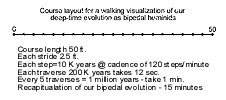 Note: Due to significant difference between size, length and tempo of strides and because each species required an unknown time to
transition from one basal speciation to another - all figures are mere approximations and we can be pretty loose in how we orchestrate
the visualization of the evolutionary stages. I give 15 minutes to complete my whole bipedal hominid evolution visualization regimen.
Note: Due to significant difference between size, length and tempo of strides and because each species required an unknown time to
transition from one basal speciation to another - all figures are mere approximations and we can be pretty loose in how we orchestrate
the visualization of the evolutionary stages. I give 15 minutes to complete my whole bipedal hominid evolution visualization regimen.
1. Provide an indoor course with total length of 50 ft. that you can navigate in a brisk walk.
2. Let's begin our bipedal visualization at a reasonably credible moment in the early Miocene when out of hundreds of species of early apes
scattered throughout Eurasia and Africa - one, in our human lineage, (yet identified) evolved obligate bipedalism (roughly between the time
of
Proconsul
- 18 Mya and
Pierolapithecus
- 13 Mya, or around 15 Mya.
3. Each length of the course equals 200 K years. A brisk human stride averages 2.5 feet which takes 20 steps to cover one length of 50 ft.
course. Each step equals 10 K years. The tempo of stride is roughly 120 steps per minute so time to cover each length of course is roughly
12 seconds. Every 5 lengths of course covered amounts to 1 million years and takes around 1 minute. To visualize your evolution starting
with 15 Mya (post Proconsul) through Sahelanthropus of 7 Mya to Ardipithecus around 5 Mya - takes 50 course lengths or roughly about 10
minutes.
4. Evolving to Australopithecus afarensis of 3.2 Mya takes just 10 course lengths and about 2.5 minutes.
5. To A. sediba of 2.2 Mya ago - 5 course lengths and 1.25 minutes.
6. To Homo heidleburgensis of 500 Kya roughly .5 minute.
7. To Homo sapiens 200 Kya about .1 minute.
8. The total time for a recapitulation of our bipedal hominid evolution is about 15 minutes (+ or - 1 Mya). (For a
shorter stride - say 2 ft. - simply shorten the course to 40 ft and with cadence unchanged - the time components will
remain the same and still provide a 15 min. visualisation of our bipedal evolution.
9. When I arrive at 1 Mya I evoke a strong vizualization of deep time passing not only with each 10 K step but in
hundred-thousand-year increments for every half_course length traversed - 900/800/700/600/half-million/400/etc. to
provoke a palpable sense of the profound scope of evolutionary deep time.
10. When I visualize the last 200 K course - half way at 1 Kya I become
Herto man
(fully sapiens sapiens) then 70 Kya first leaving Africa then in quick succession - 50 Kya another wave of sapiens leave Africa, 12 Kya
Göbekli Tepe
builder, 4 Kya Egyptianns, 2 Kya Romans, napolianic era, world War I, and finally World War II and doing a seamless integration where I
continue my route for another five minutes with a marching cadence while whisper-whistling the theme from the 1957 movie
Bridge On the River Kwai
(an epic dramatization of the existential range of modern human ambition - starring Alec Guiness) marshaling me to engage in whatever
tasks I've planned for my day. I end the total 20-minute contemplative workout transfixed staring at the ceiling light in the adjacent
kitchen as my wholly evolved self - merged with the divine.
Update 02 25 12: When my meditation session has ended, in the moment after I've made my closing salutation to Ananada, my eyes are closed shut and my field of vision is essentially dark and featureless. I needed a visualization that carries me from there to the wide-eyed but stupefied state my meditation produces - where I begin my 15-minute (million year-per-minute) walk transitioning me from ape-brained hominid through to my

 I created an animated gif
Evolution 1-Minute Slideshow
that presents graphic hyperlinks in our human phylogeny from the origin of life to Homo sapiens. While my eyes are still tightly closed,
I imagine the dark and featureless state of life's first perception. As I expand my brow, my field of vision is flooded with featureless
light and I visualize my life first emerging in two stages of single-celled organisms. Then- still with eyes closed, I imagine becoming
a sea squirt larvae, then lancelet - an eyeless extant species with basal similarities to
pikaia
from 540 Mya - eyeless but increasingly able to discriminate light qualities and considered to be the archetypal vertebrate form.
I created an animated gif
Evolution 1-Minute Slideshow
that presents graphic hyperlinks in our human phylogeny from the origin of life to Homo sapiens. While my eyes are still tightly closed,
I imagine the dark and featureless state of life's first perception. As I expand my brow, my field of vision is flooded with featureless
light and I visualize my life first emerging in two stages of single-celled organisms. Then- still with eyes closed, I imagine becoming
a sea squirt larvae, then lancelet - an eyeless extant species with basal similarities to
pikaia
from 540 Mya - eyeless but increasingly able to discriminate light qualities and considered to be the archetypal vertebrate form.

As I open my eyes fully to confront the ceiling light and discern objects, I imagine I am a conodont - vertebrate with fully optical eyes - and in rapid succession, imagine being the fish, amphibian, reptile, cynodont and mammal that evolve into the first hominid with incipient bipedalism - then put my drum aside and begin my 15-minute (million year-per-minute) walk transitioning me from an ape-brained hominid (Post Proconsul) through to my Homo sapiens sapiens evolution.
 My walk starts as an upright creature about the size of a female gorilla whose brain remains virtually flat-lined for two thirds of
its bipedal evolution to becoming a fully modern human. [Vitruvian Man Homo sapiens] At the end of my entire walk I stand transfixed for
a moment before my ceiling light and assume the stance of
Vitruvian Man
and become as Leonardo's rendering implied.
- completing my Primordial Rhythm Meditation session. (My post meditation walk lasts a total of 20 minutes but sometimes I extend this time
for another 10 minutes on days I plan to miss my walk to the library.) This could be an ideal time for any housebound meditator to add an
aerobic regimen as a daily practice.
My walk starts as an upright creature about the size of a female gorilla whose brain remains virtually flat-lined for two thirds of
its bipedal evolution to becoming a fully modern human. [Vitruvian Man Homo sapiens] At the end of my entire walk I stand transfixed for
a moment before my ceiling light and assume the stance of
Vitruvian Man
and become as Leonardo's rendering implied.
- completing my Primordial Rhythm Meditation session. (My post meditation walk lasts a total of 20 minutes but sometimes I extend this time
for another 10 minutes on days I plan to miss my walk to the library.) This could be an ideal time for any housebound meditator to add an
aerobic regimen as a daily practice.
The Context of Humanity: Understanding Deep Time A. R. Palmer, Institute of Cambrian Studies, Boulder, CO and E-an Zen, University of Maryland, College Park, MD. Demonstration 4 - To really put the impact of humans into the deep time perspective, an effective basis for an analogy is a football field (actually a soccer field is better because it has metric dimensions and so the math is easier). If the age of the Earth (4.5 billion years) is scaled to the length of a soccer field, depicted at the top of a sheet of paper or overhead transparency, then one millimeter equals 45,000 years. Most of what we commonly study as human history has all happened since the beginning of the agricultural revolution - about one tenth of our original millimeter of the soccer field, or roughly the thickness of a blade of grass on the goal-line!
Deep Time Walk - The Deep Time Walk app helps people walk a story of Earth's evolutionary journey. It is an ongoing research project which invites people to share scientific, philosophical and cultural ideas as part of a roving discussion and walk through "deep" or geologic time. New version adds innovative features; Gaiaphonic Audio, Clock-time Remaining Indicator, swipe and slide UI gestures and the integration of 'What's Next' portal for positive action (with organisations such as Earth Charter, 350.org and Transition Towns). See: Interactive Deep Time (Google Play).
Britain's Ancestor's Trail Smithsonian Magazine, January 2014 by Jerry Adler This is a pilgrimage of sorts, a hike that is also a metaphorical voyage backward through 3.5 billion years of evolution, an unbelievers' pilgrimage inspired by the biologist and polemical atheist Richard Dawkins. Specifically, we are re-enacting the imaginary walk through time described in Dawkins' book The Ancestor's Tale, a history of life that takes the usual metaphor of evolution, a tree with roots in the Precambrian and branches for all the major phyla, and turns it upside down. Dawkins begins his account in the present and traces the human lineage back to the hypothesized single cell that set the whole process in motion by dividing in two. (mg commentary: I was offended by the snide tone of secular imperative in the article that insinuated that only individuals who embrace Dawkins' atheist philosophy will be able to fully appreciate and properly integrate the involutionary experience. Of interest is the coincidence that each step of the first ten million of the 3.5 billion year journey of the 14 mile course equals ten thousand years of evolutionary time - the same period as each step in the indoors 50-foot course that I describe for recapitulating our hominid evolution from 8 million year old Nakalipithecus to Homo sapiens sapiens.)
The Cosmic Calendar A method to visualize the vast history of the universe in which its 13.8 billion year lifetime is condensed down into a single year. In this visualization, the Big Bang took place at the beginning of January 1 at midnight, and the current moment is mapped onto the end of December 31 at midnight. At this scale, there are 438 years per second, 1.58 million years per hour, and 37.8 million years per day. This concept was popularized by Carl Sagan in his book The Dragons of Eden.
Earth Empathy Adventure planetary connecting A portal resource presenting a variety of practices designed to experience a sense of integating our deep-time biological and cosmological evolution.
Evolutionary Enlightenment
by Andrew Cohen. I ask everyone to take the risk of dropping their relationship to anything and everything except life's most profound
spiritual truths and biggest philosophical questions' like:
Who am I? . . . Who am I REALLY?
Why am I here in this world?
Why does the universe exist?
Why did something come from nothing?
Does the life I live mean anything?
Is there an ultimate purpose to existence?
Together, deep meditation and profound contemplation make up the tried and true path to enlightened awareness. Aspiring for
enlightenment requires you to do both these things: Sit still like a beautiful stone statue of the Buddha and continuously let go of
your mind and your thoughts until you glimpse - even if only for an instant - the same awe-inspiring mystery of the empty void that he
did. Then, when you are relatively free from the endless onslaught of conditioned thinking, become a philosopher. Like Socrates,
Descartes, or Heidegger, dare to question everything you already think and already believe. See Also:
Evolutionary Impulse
Chapter I of Cohen's book.
Note:
The focus of my maya-gaia website is to suggest answers for these same questions plus a hint for one other -
"Where am I going?".
It also offers an alternative - Primordial Rhythm Meditation - for integrating
sat-chit-ananda
as a daily practice. Cohen's
view on meditation
however, where "stillness" is one of his three "essential" parameters - is a major contrast with my PRM active meditation. From the slim archive of accounts of authentic
Nirvikalpa Samadhi
that have arisen unintended, spontaneously, with no spiritual context over a wide range of scenarios - it seems the prerequisites by
which uncertain "enlightenment" grace is blessed are a complete and absolute enigma. Thus may be why the Buddha purportedly said:
be a lamp (island or refuge) unto yourself.
See Also:
Credibility Yoga
and
Jnana Bhakti Tension
An Evolutionists Meditation On the Miracle Of Being An opening invocation presented by Ashok at the California Institute of Integral Studies, 2012. (mg comment: Ashok intellectually arrives at an advanced philosophy that is an essence of samadhi revelation. For continued Self-evolution, Alan Watts opined that to unbox, one finds harmony by accepting reality as a 200% universe - concurrently dual material and non dual. Ultimate integration may be to embrace and commune with divine consciousness as a daily practice.)
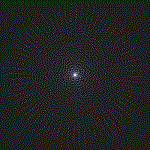 Primordial Rhythm and Mathematics
a profound holistic synthesis towards science/spirituality by Ganesh Blog, 2013. In the last few decades the mainstream modern science has
started accepting concepts like uncertainty principle, wave mechanics, quantum mechanics, and periodicity of the wave pattern. Most
importantly it is about the fundamental wave pattern of any energy or matter and the harmonics of these wave patterns falling in a
particular form and proportion which is dictated by geometry/mathematics. In all the modern scientists are still trying to understand
the depths of science of the subtle aka the sacred spatial geometry. The understanding about the human body especially, "the spatial
awareness that exists in each and every cell is due to the different sensory organs tuned at frequencies", led the scientists to unravel
the innate spatial geometry of life.
Primordial Rhythm and Mathematics
a profound holistic synthesis towards science/spirituality by Ganesh Blog, 2013. In the last few decades the mainstream modern science has
started accepting concepts like uncertainty principle, wave mechanics, quantum mechanics, and periodicity of the wave pattern. Most
importantly it is about the fundamental wave pattern of any energy or matter and the harmonics of these wave patterns falling in a
particular form and proportion which is dictated by geometry/mathematics. In all the modern scientists are still trying to understand
the depths of science of the subtle aka the sacred spatial geometry. The understanding about the human body especially, "the spatial
awareness that exists in each and every cell is due to the different sensory organs tuned at frequencies", led the scientists to unravel
the innate spatial geometry of life.
Update 12 07 11:
I have come to recognize some subtle aspects in the evolution of my practice - mostly in regards to the tempo and rhythm of my drumming.
I want to believe that my "intuition" is determining my orchestration so that I don't have to conform to any prescription relating to
various brain wave and sound entrainment theories (which are really only speculation as it relates to metaphysical reality). Of course
it is impossible to distinguished "intuition" from all the other ways in which we may sense and interpret implicit messages. (It may be
that intuition is synonymous with
"perception"
that represents a first state of our
"cognition"
process before it becomes modulated by: instinct, memory, counter-intuition, imagination, knowledge, conditioning, constructionism,
possession, hypnotism, chance, chaos, determinism,
Bayesian probability,
, etc.) In the end we are left with faith that we can detect pure, unadulterated intuition to guide us in arriving at our belief for
making decisions - absent all the cogitating influences. That said, my orchestration tends to incorporate the idea that our mother's
heartbeat provides a template for our basic meditative rhythm and since her rhythm varied over a range (estimated) of between 30 and
100 bpm - this is the range for my swaying rhythm on which I overlay my triple drum beat. This results in a range for drumbeats from
90 to 300 bpm that corresponds to a brainwave tempo ranging from Delta to Theta. I find drumbeat tempos above 180 bpm distracting, and
feel that favoring a swaying tempo corresponding to my own pulse rate between 30 and 60 per minute -
See heartbeat update
with triple drum beats per-sway - keeps me within a comfortable sense of communion.
End Update
A practical function that makes my jug drum - along with the udu bottle drum somewhat unique is that relative to the drummer- most of the sound energy from typical drums is broadcast outward which is ideal for an extrovertive performance to reach an audience, whereas most of the sound energy of the jug drum is directed inward. This makes it particularly suitable for an introvertive practice by directing a full range of sound energy directly into the meditator's consciousness without needing the amplitude of a broadcast instrument likely to disturb the neighbors.
Update 08 11 2011: In performing my rhythm meditation over the past couple of weeks I've become aware of the subtle variations in tone and tempo of my drum beat and allow my intuition to override my preconceptions about the "proper" configurations for attaining particular brain waves. I find I tend to play whatever combinations of monotonous beats that best maintain my sense of rhythm without allowing any creative syncopation to intrude in the monotony of the tempo. I expect to eventually settle down to fewer arbitrary variation. I've also noticed that finger tapping on the face of my sacred Purex drum is much more intuitive and natural ergonomically than tapping upwards on the bottom of my demonstration Clorox container.
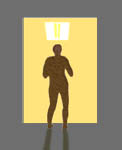 I have come to realize that through a series of fortuitous events in the general disarray in the way my condo is configured, I am
performing my practice in a setting that is ideal for my meditation that has spontaneously provided an element in synchronicity
with my practice that had not occurred to me. I started my meditation in the mornings - after bath and breakfast prepared to meet
my day except for getting dressed. I stand in my most comfortable spot on the only floor space (6'x 8') that is carpeted in my condo.
In the floor plan this was intended as a dining area (now converted to my computer office) and it's adjacent to my kitchen. The only
electric light for this area is from a pair of bare florescent lights I had retrofitted below the original kitchen ceiling fixtures
whose transformer had failed several years ago. I never replaced the diffusion panel that cut the glare from the bare lights. Without
really thinking about it I (instinctively?) stood facing this light and just before dedicating my meditation to
Sat-Chit-Ananda
unconsciously absorbed the radiation. It is only recently that I realized this was an essential component in my meditative anatomy and that
it is the visible manifestation of what I describe in my
Cosmic Model
viz: light as cosmic consciousness. So now as an integral part of my meditation I add light to the water, elements and air in my
contemplation of Chit and give conscious acknowledgement and reverence to the light before closing my eyes to begin my dedication.
End Update
I have come to realize that through a series of fortuitous events in the general disarray in the way my condo is configured, I am
performing my practice in a setting that is ideal for my meditation that has spontaneously provided an element in synchronicity
with my practice that had not occurred to me. I started my meditation in the mornings - after bath and breakfast prepared to meet
my day except for getting dressed. I stand in my most comfortable spot on the only floor space (6'x 8') that is carpeted in my condo.
In the floor plan this was intended as a dining area (now converted to my computer office) and it's adjacent to my kitchen. The only
electric light for this area is from a pair of bare florescent lights I had retrofitted below the original kitchen ceiling fixtures
whose transformer had failed several years ago. I never replaced the diffusion panel that cut the glare from the bare lights. Without
really thinking about it I (instinctively?) stood facing this light and just before dedicating my meditation to
Sat-Chit-Ananda
unconsciously absorbed the radiation. It is only recently that I realized this was an essential component in my meditative anatomy and that
it is the visible manifestation of what I describe in my
Cosmic Model
viz: light as cosmic consciousness. So now as an integral part of my meditation I add light to the water, elements and air in my
contemplation of Chit and give conscious acknowledgement and reverence to the light before closing my eyes to begin my dedication.
End Update
 The approach that came closest to my preliminary model for an active meditation protocol was provided in the works of
Michael Harner,
the founder and president of the Foundation for Shamanic Studies. Harner pioneered the introduction of shamanism to contemporary life
and is recognized as the world leader in this movement. His
Core Shamanism
consists of the universal, near-universal, or common principles and practices of shamanism not bound to any specific cultural group or
perspective. Since the West overwhelmingly lost its shamanic knowledge centuries ago due to religious oppression,
Core shamanism
does not focus on ceremonies, such as those of Native Americans, which are part of the work of medicine men and women, persons who do
both shamanism and ceremonial work. See also:
Stan Grof & Michael Harner
a youtube video discussion about shamanic concepts and Buddhism.
Healing
An About.com summary on resources for meditation for healing, features Michael Harner drum protocol.
The approach that came closest to my preliminary model for an active meditation protocol was provided in the works of
Michael Harner,
the founder and president of the Foundation for Shamanic Studies. Harner pioneered the introduction of shamanism to contemporary life
and is recognized as the world leader in this movement. His
Core Shamanism
consists of the universal, near-universal, or common principles and practices of shamanism not bound to any specific cultural group or
perspective. Since the West overwhelmingly lost its shamanic knowledge centuries ago due to religious oppression,
Core shamanism
does not focus on ceremonies, such as those of Native Americans, which are part of the work of medicine men and women, persons who do
both shamanism and ceremonial work. See also:
Stan Grof & Michael Harner
a youtube video discussion about shamanic concepts and Buddhism.
Healing
An About.com summary on resources for meditation for healing, features Michael Harner drum protocol.
Michael Harner Wikipedia Regarding centered use of ritual drumming and dance, and Harner's interpretations of various indigenous religions. Harner has faced criticism for taking pieces of diverse religions out of their cultural contexts and synthesizing a set of universal shamanic techniques. Some neoshamans focus on the ritual use of entheogens, as well as embrace the philosophies of chaos magic whilst others (such as Jan Fries) have created their own forms of shamanism.
Another useful perspective is provided in the book I Ching: The Tao of Drumming by Michael Drake - Drumming offers a relatively easy means of controlled transcendence. Researchers have found that if a drum beat frequency of around 180 beats per minute is sustained for at least 15 minutes, an [Sic] alpha wave cycle manifests in the brain and it will induce significant altered states in most people, even on their first attempt. This ease of induction contrasts significantly with the long periods of isolation and practice required by most passive meditative disciplines before inducing significant effects. Rhythmic stimulation is a simple and effortless technique for affecting states of mind. Michael Drake shamanic drum CD and downloads
Frame Drum Spiritual Rites by Lane Redmond - The first sound we hear is the pulse of our mother's blood. We vibrate to this primordial pulse even before we have ears to hear. All the eggs a woman will ever have form in her ovaries when she is a four-month-old fetus. This means that the sacred egg that developed into the person you are now, formed in your mother's ovary when she was growing in the womb of her mother. Each of us, male and female, spent five months in the womb of our grandmother, rocking to the beat of her blood. And our mother spent five months rocking to the pulse of her grandmother's blood, and her mother pulsed to the beat of her grandmother's blood. Back through the pulse of all the mothers and all the grandmothers, through the beat of the blood that we all share, this sound returns us to the preconscious state, to the inner structure of the mind, to the power and the source of who and what we actually are: the pulsing unified field of all consciousness existing everywhere, within everything, beyond past, present, or future. The sound of the drum has represented this primordial pulse of creation since the beginning of human ritual. It is an ancient thought that rhythmic sound is at the root of all creation, that the world is structured by sound, and that life is rhythm.
Each of these researchers take the scale and scope of efficacy of shamanic drumming further than I find comfortable to include in my meditation but each has provided valuable insight for its basic structure. My practice is essentialy a synthesis of features from shamanism and non dual traditions that results in an improvised bhakti yoga active meditation.
Metronome Drum Beats 120 and 180 BPM
Rhythm Epigenises Exploring sexual dimorphisim in the evoluton of diverse species of birds of paradise and bowerbirds as it relates to those evolutionary processes that may have shaped a young human child's ability - unique among all other animals - to express motor skill in synchronization to ambient musical beats and tempo.
Drum Circle Disease Beware the threat of animal hide drumheads. Case history of participants in drum circles becoming infected with anthrax bacteria.
Examples of Other Traditions and Philosophies Involving
Sound in Meditation and Spiritual Ritual
Today Gratitude Louie Schwartzberg's ten-minute YouTube presentation of the miracle of TODAY GRATITUDE in the series of inspirational "Talks" by TEDxSF productions...that artfully dramatizes the spirit of bhakti embraced in Primordial Rhythm Meditation.
Om - Omkara seed mantra By uttering it properly one enters into direct communion with God. The bliss of Turiya, which I will discuss shortly, is seen as the spiritual presence of Vishnu. For the non-theist, Om is the primordial emanation of nirguna brahman into saguna, which is to say, through It, the Unmanifested Totality becomes manifest. According to the Mandukyopanishad, which is a treatise on the Omkara, Om is the primal manifestation of nirguna brahman. All existence, both imminent and transcendent, is identical with the Om. In other words, the Unmanifest Reality is first conceived through the Omkara. When Om manifests, it takes on the physical forms of individualized matter. Technically, this existence is known as Prakriti. Om is the foundation of matter.
Human Sense of Rhythm Neurologist Oliver Sacks states that chimpanzees and other animals show no similar appreciation of rhythm yet posits that human affinity for rhythm is fundamental, so that a person's sense of rhythm cannot be lost (e.g. by stroke).
The Ecstatic Path To Healing In Psychotherapy by Belinda Gore Ph.D.. The method for introducing ecstatic trance and the techniques for incorporating ecstatic experiences into the healing process will be discussed.Before our first trance session I review in detail the five basic elements that underlie ecstatic experience. The fourth necessary element for inducing ecstatic trance is the presence of a consistent rhythmic sound to cue the nervous system to open "alternate organs of perception." The regular sound of the rattle [or drum], at a rhythm of 200-210 beats per minute, has both a stimulating and eventually a soothing effect. The sound alerts the body to change, to enter the world of Alternate Reality, and eventually to return to ordinary consciousness.
An Exploration of Psychoacoustics: Music for Meditation and Deep Relaxation by Christopher Lloyd Clarke, B.Sc, Msc.D - Listen 4 min meditation music - Deep Within
Like "Spirit", the Soul - is the purely immortal, immaterial and divine principle which resides in the heart of man. Consequently, spirituality is the experience, the direct communion between two Divine Entities: the "Spirit" and the Soul. Anyone who has had a spiritual experience knows that such an experience cannot be described with mere words and that spiritual experiences are much more profound relative to the psychic ones..."manthra spenta" is the Soul of Ahura Mazda. It is the embodiment of Cosmic Energy originating from Ahura Mazda Who is the Source of Endless Light ("raevat-khvarnvat"). Manthra are rooted in "staot yasna". "Staot" means the Primordial Sound (vibrations) created by the First Ray of Light which burst forth at the beginning of Creation, and is diffused throughout Nature.
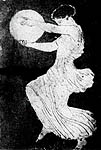 Frame Drum
Why the Frame Drum Was at the Core of Ancient Mediterranean Spiritual Rites
by
Layne Redmond
- It is an ancient thought that rhythmic sound is at the root of all creation, that matter is structured by sound, and that life is
rhythm. In India the influence of rhythm and tuning on consciousness has been explored for thousands of years and is considered a
form of yoga - Nada Yoga. The primary concept of nada yoga is that ultimate reality emanates from a primordial first sound, the pulse,
or big bang that creates the universe. The frequencies of this root vibration create our physical world. As human beings, we are also
emanations of this vibration and subject to the laws of sound. This archetypal pulse of consciousness vibrates within us as the sound
of our own heart beating.
Frame Drum
Why the Frame Drum Was at the Core of Ancient Mediterranean Spiritual Rites
by
Layne Redmond
- It is an ancient thought that rhythmic sound is at the root of all creation, that matter is structured by sound, and that life is
rhythm. In India the influence of rhythm and tuning on consciousness has been explored for thousands of years and is considered a
form of yoga - Nada Yoga. The primary concept of nada yoga is that ultimate reality emanates from a primordial first sound, the pulse,
or big bang that creates the universe. The frequencies of this root vibration create our physical world. As human beings, we are also
emanations of this vibration and subject to the laws of sound. This archetypal pulse of consciousness vibrates within us as the sound
of our own heart beating.
Meditation Beats Dance for Harmonizing Body and Mind A study published in the December 2010 issue of Emotion suggests people who regularly practice meditation are in better sync with their body than professional ballet and modern dancers. (PRM may integrate the positive effects of each discipline.)
An example of a New Age Shamanistic ritual/ceremony self invention -The definition of a shaman is, "A healer whose power and knowledge derive from intimate, ongoing relationships with personal helping spirits" - as stated by Tom Cowen in The Pocket Guide to Shamanism. A shaman is anyone who heals by connecting with the subconscious, another world, whether of spirits or intuitions, a microcosm, which can be connected to the macrocosm (Cowan 118). "As within, so without. As above, so below", The Emerald Tablet circa 3000 BC (Byrne).
Nature and Human Society: the quest for a sustainable world - Editor Peter H. Raven [Chapter: Religion and Sustainability by James Parks Morton - Page 453] From earliest times, human beings have noticed patterns in nature: night and day, tides and lunar cycles, the changing seasons, plant succession, and animal migration. Spiritual asceticism teaches us that nothing is more vital than the urgency of rhythm. Rhythm itself is the basis of all religious practice, coming from our private internal and inescapable rhythm of the heartbeat - hence, the primordial urgency of the shaman and his drum, of music as the handmaid of religion with tambourines and thundering organs and deeply monotonous unvarying chants. These rhythms sustain us and get us through life. Weekly rhythms, feasts and fasts, the rhythm of the seasons with solstices and equinoxes, spring and fall,the summer powwow and the piercing sundance - they make our blood circulate.
The Shamanic Drum: A Guide to Sacred Drumming by Michael Drake [Page 27] A two-beat rhythm produces a different sonic experience. The soft,steady lub-dub, lub-dub of a heartbeat rhythm at around 60 beats a minute (or 120 hearthrobs per minute since each heartbeat has two acoustic pulses), has a calming and centering affect. It reconnects us to the warmth and safety of the first sound we ever heard - the nurturing pulse of our mother's heartbeat melding with our own.
Essene Communion With the infinite
- Lightning Flashes in the Gathering Storm by Edond Bordeaux Szekely - The Noon Communion With the Cosmic Ocean of Sound. The
Lifestream - communion with nature and food from trees, milk, grass (cook not?) - "In the beginning was the Sound, and the Sound was
with God, and the Sound was God" -The Essene Gospel of Peace.
Mother Sound
You are lying relaxed. in a mountain stream, the water flowing cool around you in a direction from head to foot. on
both sides of the stream are banks of flowers and grass, and in the distance shrubs and trees, warm sunlight filtering
through the green leaves. Breathe deeply, repeat to yourself the words "Sound, Stream", and concentrate only on the rushing,
soothing sound of the flowing waters of the swift stream. Let the sound penetrate your mind and body until you hear in your
inner ear the "Music of the Spheres" of Pythagoras. At the end of this communion, say "Thank you, Mother Earth, for your
sounds, healing my body and mind, and lifting me into the presence of the Eternal and Infinite Soundstream.".
The Soundstream
"Now, what is music? Music is a strange thing. I would almost say it is miracle. For it stands halfway between
thought and phenomenon, between spirit and matter, a sort of nebulous mediator, like and unlike each of the things it
mediates-spirit that requires manifestation in time and matter that can do without space. We do not know what music
is." (Heine) According to Pythagoras, we are bathing in the Music of the Spheres from the moment of our birth, but
because of that very fact, we are not aware of this holy Sound which fills our inner ears. Only if we were to suddenly stop
hearing it, would we be aware of it, through its loss. When we practice this Ultimate Communion with Mother Sound, we
gradually come to an awareness of this Eternal Music which is one of the paths of the infinite. "In the beginning was
the Sound, and the Sound was God."
Lightstream at night
In concentrating on the Lightstream, the eternal brilliance of the Cosmic Ocean of Light, we gradually set the stage
for the final step that will unite us with the Heavenly Father, reaching complete union with the totality of all laws,
the One Law. By submerging ourselves in an Ocean of Light, and concentrating on the star-filled sky before going to sleep,
we ensure that through the night our subconscious mind will be in contact with the vast storehouse of superior cosmic forces,
making it possible for sleep to become a source of deepest knowledge."
"is there any wise man who will listen
To that solemn music which arises in the sky?
He, the Source of all Music,
He is the Pritnal Word. . .." (Kabir)
"I hear the melody of His flute,
And I cannot contain myself ..
The sky roars and the lightning flashes,
The waves arise in my heart...
Where the rhythm of the world rises and falls,
Thither my heart has reached:
His work and His rest are filled with music. . ." (Kabir)
Examining the Archetype - from Carl Jung to extrapolated concepts and forms. The term archetype became associated with Carl Jung. In Jung's terms, 'Archetype' is defined as the first original model of which all other similar persons, objects, or concepts are merely derivative, copied, patterned, or emulated. These patterns derive from a universal collective unconscious which in metaphysics is called the Grids, Akashic Records, Sea of Consciousness, that which creates our reality In this context, archetypes are innate prototypes for ideas, which may subsequently become involved in the interpretation of observed phenomena.
Primordial Tones: Meditation on the Archetypal Energies of Celestial Bodies by Joachim-Ernst Berendt, 1987. In recent years, Berendt has written books and articles and given lectures, workshops, and seminars about the conscious-widening aspects of sounds and tones and about the spiritual (yin) ability of the human ear as compared to the more rationalistic (yang) ability of the eye. His books about these subjects are Nada Brahma- The World Is Sound and The Third Ear.
David Hykes and the Harmonic Presence Foundation - Harmonic Presence Retreats and Concerts: Music of the Spheres and the Harmonics of Being: The Foundation organizes international seminars, retreats, concerts and festivals, sharing global teachings which explore the deep nature of harmony in mind, life, and the universe, along with practices which help our re-attunement to it through the universal contemplative music called Harmonic Chant, mindfulness and meditation training, and healing harmonization practices. See David Hykes youtube mix
Shamanic Drumming
Siberian shaman waking the drum ceremony
Sacred Hoop
Shamanic Drumming
Zen Buddhist Chant (audio)
Tibet Buddhist Monks
Green Tara Mantra: Throat Chanting
Conscious Army
Lakota drum and chant
Om audio over BBC Life on Earth video
- Snow geese migration over Himalayas.
Delta Binaual Beat Audio Session (3Hz) one hour
Theta Binaural Beat Audio Session (7Hz) one hour
Hmong Shamanism The Hmong people, an ancient people of China with a 5000 years of history, continue to maintain and practice its form of shamanism known as "Ua Neeb" in mainland Asia. At the end of the Vietnam War, some 300000 Hmong have been settled across the globe. They have continue to practice Ua Neeb in various countries in the North and South America, Europe and Australia. In the USA, Ua Neeb (the Hmong shaman practitioner is known as "Txiv Neeb", Txiv Neeb has been licensed by many hospitals in California as being part of the medical health team to treat patients in hospital. This revival of Ua Neeb in the West has been brought great success and has been hailed in the media as "Doctor for the disease, shaman for the soul".
Mythic Rhythm Listening in the Bardo: Hearing Beyond Sound, 2011 - Metaphysical perspectives on sound, music and awareness and Other Essays by Kris Oster.
Did Meditating Make Us Human? by Matt J. Rossano - Imagine you traveled back in time 100,000 years and happened upon a group of our ancestors gathered around an evening fire. Would anyone be surprised to find them chanting, clapping, dancing in unison, or maybe just sitting mesmerized before the flickering flame? The thesis of this article is that this commonplace activity, which I will call campfire rituals of focused attention, created an important selective pressure in the evolution of the modern human mind.
 Bhakti
is a Sanskrit term that signifies an attitude of devotion to a personal God that is typically based on a number of human relationships
such as beloved-lover, friend-friend, parent-child, and master-servant. The Indian spiritual teacher Meher Baba states, "Out of a number
of practices which lead to the ultimate goal of humanity - God-Realization - Bhakti Yoga is one of the most important. Almost the whole
of humanity is concerned with Bhakti Yoga, which, in simple words, means the art of worship. But it must be understood in all its true
aspects, and not merely in a narrow and shallow sense, in which the term is commonly used and interpreted. The profound worship based on
the high ideals of philosophy and spirituality, prompted by divine love, doubtless constitutes true Bhakti Yoga."
Bhakti
is a Sanskrit term that signifies an attitude of devotion to a personal God that is typically based on a number of human relationships
such as beloved-lover, friend-friend, parent-child, and master-servant. The Indian spiritual teacher Meher Baba states, "Out of a number
of practices which lead to the ultimate goal of humanity - God-Realization - Bhakti Yoga is one of the most important. Almost the whole
of humanity is concerned with Bhakti Yoga, which, in simple words, means the art of worship. But it must be understood in all its true
aspects, and not merely in a narrow and shallow sense, in which the term is commonly used and interpreted. The profound worship based on
the high ideals of philosophy and spirituality, prompted by divine love, doubtless constitutes true Bhakti Yoga."
Neuroscience Reveals the Secrets of Meditation's Benefits Scientific American, Nov, 2014. Contemplative practices that extend back thousands of years show a multitude of benefits for both body and mind By Matthieu Ricard, Antoine Lutz and Richard J. Davidson. When the Society for Neuroscience asked Tenzin Gyatso, the 14th Dalai Lama (the leader of Tibetan Buddhism), to address its annual meeting in Washington, D.C., in 2005, a few hundred members among the nearly 35,000 or so attending the meeting petitioned to have the invitation rescinded. A religious leader, they felt, had no place at a scientific meeting. But this particular leader turned out to have a provocative and ultimately productive question to pose to the gathering. "What relation," he asked, "could there be between Buddhism, an ancient Indian philosophical and spiritual tradition, and modern science?" The Dalai Lama, putting action before rhetoric, had already started trying to find answers to his own question. Back in the 1980s, he had sparked a dialogue about science and Buddhism, which led to the creation of the Mind & Life Institute, dedicated to studying contemplative science. In 2000 he brought new focus to this endeavor: he launched the subdiscipline of "contemplative neuroscience" by inviting scientists to study the brain activity of expert Buddhist meditators. See also video: The Physiology of Meditation Like Valium and Oxycontin, without the Side Effects.
Mindfulness: Stealth Buddhist Strategy for Mainstreaming Meditation?
Huffington Post 12/02/2014 by Candy Gunther Brown, Ph.D. Promoters of "secular" mindfulness avoid using the loaded words "Buddhism" or
"religion," and may even steer clear of mentioning "spirituality" or "meditation." But the practice is essentially similar to that
taught in many Buddhist basics classes. And the hope, expressed by certain key leaders in the secular mindfulness movement, is that
introductory classes alleviate suffering for all practitioners, while providing at least some of them with a doorway into deeper,
explicitly Buddhist meditation. The most influential advocate for mindfulness in America is
Jon Kabat-Zinn, Ph.D
a professor of medicine at
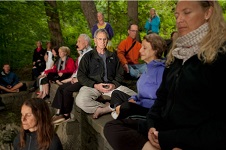 MIT
who learned mindfulness from Vietnamese Zen Buddhist monk Thich Nhat Hanh. [Mindful Meditation - Time Magazine Feb 2014] While on a
spiritual retreat at the Insight Meditation Society in 1979, Kabat-Zinn had a flash of insight to "take the heart of something as
meaningful, as sacred if you will, as Buddha-dharma and bring it into the world in a way that doesn't dilute, profane or distort it,
but at the same time is not locked into a culturally and tradition-bound framework that would make it absolutely impenetrable to the
vast majority of people." During a 1990 meeting, the Dalai Lama himself approved Kabat-Zinn's strategy of modifying vocabulary in
order to make mindfulness acceptable to non-Buddhists.
MIT
who learned mindfulness from Vietnamese Zen Buddhist monk Thich Nhat Hanh. [Mindful Meditation - Time Magazine Feb 2014] While on a
spiritual retreat at the Insight Meditation Society in 1979, Kabat-Zinn had a flash of insight to "take the heart of something as
meaningful, as sacred if you will, as Buddha-dharma and bring it into the world in a way that doesn't dilute, profane or distort it,
but at the same time is not locked into a culturally and tradition-bound framework that would make it absolutely impenetrable to the
vast majority of people." During a 1990 meeting, the Dalai Lama himself approved Kabat-Zinn's strategy of modifying vocabulary in
order to make mindfulness acceptable to non-Buddhists.
Certain anthropologists, most notably Alice Kehoe in her book Shamans and Religion: An Anthropological Exploration in Critical Thinking , are highly critical of the term. Part of this criticism involves the notion of cultural appropriation. This includes criticism of New Age and modern Western forms of Shamanism, which may not only misrepresent or 'dilute' genuine indigenous practices but do so in a way that, according to Kehoe, reinforces racist ideas such as the Noble Savage. Kehoe is highly critical of Mircea Eliade's work. Eliade, being a philosopher and historian of religions rather than an anthropologist, had never done any field work or made any direct contact with 'shamans' or cultures practicing 'shamanism', though he did spend four years studying at the University of Calcutta in India where he received his doctorate based on his Yoga thesis. A tableau presenting figures of various cultures filling in mediator-like roles, often being termed as "shaman" in the literature. The tableau presents the diversity of this concept. Also Piers Vitebsky mentions, that despite really astonishing similarities, there is no unity in shamanism. The various, fragmented shamanistic practices and beliefs coexist with other beliefs everywhere. There is no record of pure shamanistic societies.
Brainwave Entrainment A popular exposition of Brainwave Entrainment Technology and Resources. "Brainwave Entrainment7" is the process of changing your brain's electrical activity to match a form of sound or light stimulation. In order to entrain brain waves, people usually use binaural beats, isochronic tones, monaural beats, or in other cases, a mind-machine.
Music and Consciousness by Earl Vickers - This paper was originally written for a Physics of Music class in 1977. Shamanism and Psychedelia; Psychoacoustic Effects: - Polyphony; Rhythm and Auditory Entrainment; Repetitive Sounds; Spatial Effects; Timbre and Overtones
Brain Wave Entrainment A resource about scientific theories of binaural beat brainwave entrainment. When signals of two different frequencies are presented, one to each ear, the brain detects phase differences between these signals. Under natural circumstances a detected phase difference would provide directional information. The brain processes this anomalous information differently when these phase differences are heard with stereo headphones or speakers. A perceptual integration of the two signals takes place, producing the sensation of a third "beat" frequency.
Brainwave Frequency Compendium of Brainwave Frequency Listing in Cycles per second (Hertz) and correspondence to mental states, physiology,colors, notes and planets. (There's disagreement over where the delta range begins & ends - [SS,PWM+AWI] list it as 0.5 to 4.0 HZ, [NEU] 0.1 to 3.0 HZ, & [RA] considers it 0.5 to 3.0 HZ, (DW places "Theta1" Range. at 3.0-5.5 HZ.)
Conscious Rhythmic Entrainment
by Jeff Strong, 2005 - In spite of the many differences among ancient societies, very few differences emerged among their therapeutic
rhythm techniques. In fact, only three core approaches developed: Community drumming, shamanic drumming, and rhythm-healing. BETA,
ALPHA, THETA and DELTA. Each frequency has a characteristic blueprint and produces a distinctive state of consciousness:
BETA waves (14 cycles per second and above) dominate the normal waking state of consciousness when attention is directed towards the outside world.
ALPHA waves (8-13 cycles per second) are present during dreaming and light meditation when the eyes are closed.
THETA waves (4-7 cycles per second) occur in sleep and are dominate in the highest state of mediation. In deep meditation and deep sleep.
DELTA waves (.5 to 3 cycles per second) are experienced and provide the most profound feelings of peace.
Each of these brainwave frequencies serves an important function. The optimum level for deep thought is in the realm of THETA. When in THETA, the senses are
withdrawn from the external world and focused on then inner one. DELTA waves endow a total vacation from existence and provide the most
profound state achieved by only the most advanced yogis.
Toward a New Comparative Musicology PDF ethnomusicology by Patrick E. Savage and Steven Brown, 2018 - Department of Musicology, Tokyo University of the Arts, Department of Psychology, Neuroscience & Behaviour, McMaster University - We propose a return to the forgotten agenda of comparative musicology, one that is updated with the paradigms of modern evolutionary theory and scientific methodology with the overarching goal of cross-cultural musical comparison. We outline here five major themes that underlie the re-establishment of comparative musicology: (1) classification, (2) cultural evolution, (3) human history, (4) universals, and (5) biological evolution.
Music Earth -where music meets your DNA - youtube video that presents a symbolic coupling of two subjects, genetic anthropology (specifically, the genetic account of the peopling of the world, where archaeogenetics meets genography) and its correlation with the ethnic or tribal musical heritage of the related tribes (ethnomusicology or in common parlance, "world music").
Pakistan's Sufis Preach Faith and Ecstasy - By Nicholas Schmidle Photographs by Aaron Huey - Smithsonian magazine, December 2008. An experiential, first-hand report on the status of the spiritual tradition and living example of a collective drumming meditation. Believers in Islamic mysticism embrace a personal approach to their faith in stark contrast to the authoritative social and political militancy of jihadist movements.
Techno Rhythm Describing bpm in various sub-genre
Primordial Sound Meditation - a meetup group in Montreal.
Protesting Drumming's Intrusion Into Churches - and the untoward consequences.
Drums in Church? Does the Bible establish pro or con?
No Movement Without Rhythm youtube video: An African sense of musical virtuosity evolved from primordial rhythm.
African Spiritual Music - the language of the drum - The Dogon say that Drum is the ear of God and one must beat it with the attitude that one is speaking to God on behalf of mankind. (In contrast m-g's drumming bhakti meditation is restrained and intimately personal with no broader agenda to provide a collective voice.)
Following is one example of a vast global industry of neo spiritual resources that promote some form of adaptive or traditional music,
rhythm, drum, mantra, sound meditation. Click on "listen" on any CD album page to hear samples.
Rootlight
Divine Spiritual Wisdom is a unique science combining Universal Kabbalah and Naam Yoga. The practice of Universal Kabbalah will open your
heart and awaken your spirit while the practice of
Naam Yoga
will rejuvenate your body, mind and soul taught through a multitude of teaching tools including: CDs, books, an instructional DVD,
self-study courses, online classes, workshops, trainings, special events as well as the rootlight.com website featuring a library of
newsletters, lecture downloads and other instructional selections.
Since 1995, the drum-circle has met an hour before sunset every Sunday at Shepard Park in Stuart, FL.
About ten years ago I created a digital poster of the ongoing event featuring Brother Judah Williams, a master djembe drummer and facilitator and Darci a spectacular dancer. Tragically, Judah died in 2010 at age 52 of lung cancer so I'm posting these images in his loving memory. If Darci sees this, I hope she'll send an Email and let me know what's up.
A reminder of the legacy of Brother Judah Williams
Drum circle for Teens Update Martin County Events, May 8, 2009 - Expert drummer Brother Judah will present an interactive drum circle for tweens and teens at 11:00 am on Saturday, May 16 in the Community Room of the Hobe Sound Public Library, 10595 SE Federal Highway in Hobe Sound. This hands-on drum circle extravaganza includes hand drums and other percussion instruments. Brother [IN LOVING MEMORY Kirk Judah Williams, 7/28/58 � 8/19/10 We love you always- Doris, children, parents, family & friends] Judah (Judah Williams) is founder of the Sankofa World Drums/Music and Performing Arts Ensemble and presents drum circle classes to after school students in Martin County elementary and middle schools. Presented at no charge, this program is sponsored by The Friends of the Hobe Sound Library, Inc.
 Kirk Judah Williams
IN LOVING MEMORY Kirk Judah Williams 7/28/58 - 8/19/10 A year ago you left us & our lives were changed forever. We'll remember you always,
but today we hold you a little closer to our hearts. RIP, Judah. We miss you, we celebrate you, we love you- always. Doris, children,
parents, family & friends. - Published in the TC Palm on Aug. 19, 2011.
Kirk Judah Williams
IN LOVING MEMORY Kirk Judah Williams 7/28/58 - 8/19/10 A year ago you left us & our lives were changed forever. We'll remember you always,
but today we hold you a little closer to our hearts. RIP, Judah. We miss you, we celebrate you, we love you- always. Doris, children,
parents, family & friends. - Published in the TC Palm on Aug. 19, 2011.
A Beat for Brother Judah 2012 This week was a somber one for religious and spiritual communities on the Treasure Coast. The beautiful thing, however, is seeing how individuals continue to touch lives even after they are gone. The sound of African drums starts around the same time every Sunday evening at Shepard Park in Stuart. For about 20 years, a group of musicians has gathered in a drum circle and jammed while watching the sun set over the St. Lucie River. But one Sunday in August 2010, the usual drumming sound was interrupted. Something went missing. "Brother" Judah Williams, a regular in the group, had lost his battle to cancer. The 52-year-old advocated for tolerance and diversity by teaching drum rhythms to local children. "Brother Judah is here with us today," said drummer Tim Brown at Sunday's memorial drum circle. The day marked the two-year anniversary of Williams' death. The musicians laughed and tapped their feet as they dedicated sounds to a lost friend. "It's a spiritual experience today," drummer Dean Ranged said. "I've always said this (drum circle) is my spiritual cleansing for the week, but today it's in memory of Judah." As the sun disappeared into the horizon and the beat of the drums got louder, one thing became clear: Brother Judah's spirit is alive.
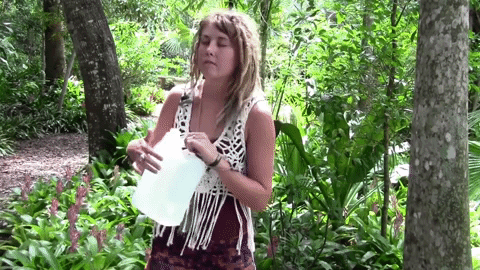
Update 08 28 2018
My offer of a Meetup subscription and scholarship to the IONS
Conscious Aging Facilitators Course
Since I'm now 90 years aged, the Primordial Rhythm Meditation video demonstrating the evolution of my PRM practice may be more creepy than inspirational. I would like to sponsor a more effective presenter to be an organizer for a Meetup anywhere in the world and make it part of a full or sideline career as coach/facilitator for the Conscious Aging Facilitators Training Guide -I'd provide scholarship.
The attributes I'm looking for in a candidate (or ability to collaborate creatively to provide) Web & video Design/Development, Science & Nonduality Philosophy, Fitness & Wellness and Social/Entrepreneuring Skills.
Realize PRM is an unconventional non-symbolic hybrid of yoga, bhakti, shamanism and various nonduality principles - heretical, agnostic and even atheistic compared to both prophetic and non dual religious traditions. It's kindof an evolved synthesis of "new" physics, Darwinian evolution and selected elements from the two most sophisticated non dual spiritual traditions - Advaita Vedanta and Kashmir Saivism and a uniquely simple active meditative practice that could appeal to a niche audience - particularly senior citizens - where it could be integrated into a fitness and wellness stress/anxiety relief regimen.
If you are interested, I'd replace all my online PRM material with webpages and videos featuring you and whatever adaptation to integrate into your practice website you want to make. PRM would be the evolving meditation modality for the IONS-Conscious-Aging-Facilitators-Guide curriculum. I'd provide a subscription to the course) - so you'd acquire a professional identity to feature in your own IONS Conscious Aging and PRM coaching website.
You can also click on anthropic maya-gaia or do a Google image search for "maya gaia anthropic" - that brings up many of my original graphics. You could reconfigure my (over 100) Web-Book pages to link to your coaching website and totally manage it when I go nondual in the next few years (auto-renewal of domains and hosting for the next 5 years is funded by a PayPal account).
Now I realize (unless you're inspired to take on its inherent existential mission) my Anthropic Trilogy Web-Book is fraught with philosophical/religious controversy so you may want to cut all ties to or from your professional coaching practice website - in which case you could present your PRM meditation practice as original in your own website and I'd remove all references to it in my Web-Book.
I know this is a lot of antithetical, nonduality stuff for any Millennial, Generation X or Boomer to wrap your young mind around but there's always a remote chance it could ring your brain bells.
Please send any replies to smalltownsATusaDOTcom End Update
Some sample outfits for a girl doing a video promo for PRM
...prefer flair (no cinched waist) and colors more pastel, Earth tones

